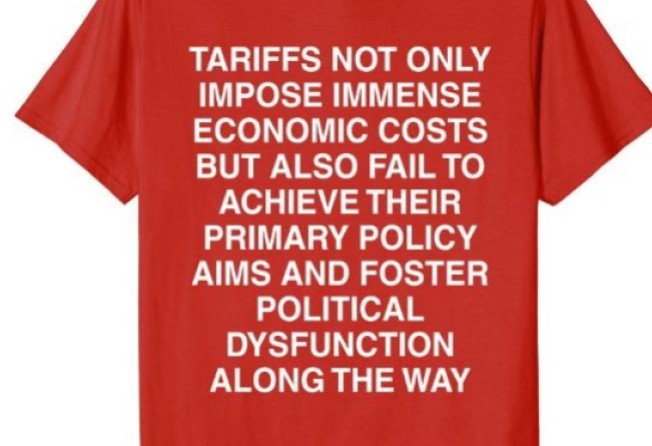— Scott Lincicome (@scottlincicome) March 11, 2018
How a T-shirt explains Donald Trump’s trade war
Trade lawyer’s tariff T-shirts go viral

This story is published in a content partnership with POLITICO. It was originally reported by Ben White on politico.com on August 8, 2018.
Scott Lincicome, a veteran trade lawyer and adjunct scholar at the free-market Cato Institute, was scrolling through Twitter one Saturday morning when he saw a photo of a woman at a Donald Trump rally wearing a T-shirt that said something like “Tariffs are great!”
Then he had an inspiration. He would create his own shirt highlighting how difficult it is for opponents of protectionist trade policy to combat these kinds of easy slogans.
The shirt, which quickly went viral and has appeared on NBC, Bloomberg and other TV networks reads: “Tariffs not only impose immense economic costs but also fail to achieve their primary policy aims and foster political dysfunction along the way.”
All proceeds from sales of the shirts go toward financial education programmes.
IT'S TIME WE FOUGHT BACK NOW WHO'S WITH ME pic.twitter.com/dXe2na3yRU
— Scott Lincicome (@scottlincicome) March 11, 2018
OH MY! Now @NumbersMuncher has made the Super Deluxe Version, with the same great #TNOIIECBAFTATPPAAFPDATW catchphrase on the front, PLUS the classic tariff/deadweight loss graph on the back! Profits still go to economics education charity! https://t.co/6sYSuDJXpi pic.twitter.com/gqlgjzqsho
— Scott Lincicome (@scottlincicome) March 12, 2018
On the latest episode of the POLITICO Money podcast, Lincicome explained the dilemma that led to the T-shirt.
“The protectionist side has a three-word issue: ‘Trade kills jobs’,” he said.
“Whereas the other side comes back with: ‘Actually the composition of jobs changes and we get better jobs’, and by that point the audience has fallen asleep.”
While it may be hard to explain, Lincicome argues, Trump’s campaign of tariffs on steel, aluminium and imported Chinese goods is already hitting the US economy and could get much worse if more levies are added beyond the current US$34 billion in Chinese imports.
(The Trump administration announced late Tuesday that it will add tariffs to an additional US$16 billion in Chinese imports as of August 23.)
And he rejected the argument made by Commerce Secretary Wilbur Ross that even at $200 billion or more in goods, the tariffs would be a tiny sliver of an $18 trillion-plus US economy.
“This is what I call the ‘So I burn down your house but at least the neighbourhood is fine’ argument and it fails on a couple points,” he said.
“There are going to be real harms to real companies, individuals, farmers, exporters, importers. Those folks are going to have real harms.”
“The other problem with that is it completely ignores the indirect effects of tariffs,” Lincicome added. “Not only are you going to see a $50 billion tax on these products, but you are going to see domestic prices for directly competing goods go up as well. So that is another new tax on consumption. You are going to see knock-on effects. If companies go into bankruptcy, those have multiplier effects.”
Lincicome said the US is not yet in a full-blown trade war. But it might be soon.
“We trade guys hate to use the term ‘trade war.’ At this stage we are still in trade dispute/trade skirmish,” he said.
“We will shift into trade war I think if this big tranche, this $200 billion [on China] ends up getting implemented. And we are not going to know about that for at least another six weeks, give or take.”